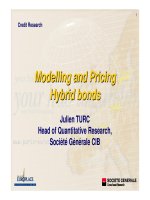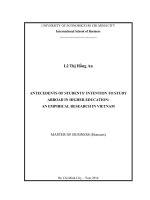Quantitative research in public management session 2
Bạn đang xem bản rút gọn của tài liệu. Xem và tải ngay bản đầy đủ của tài liệu tại đây (641.58 KB, 30 trang )
Session 2 – Part 1
Searching and Reviewing
Literature
School of Business
I N T E R N AT I O N A L U N I V E R S I T Y - V I E T N A M N AT I O N A L U N I V E R S I T Y H C M C
Literature Review
• Once you have identified a research topic, you need to start collecting and analysing the literature in
order to identify a research problem to investigate
• The literature is ‘all sources of published data on a particular topic’ and a literature search is ‘a systemic
process with a view to identifying the existing body of knowledge on a particular topic’ (Collis and
Hussey, 2009, p. 91)
Tri D. Le
2
Literature
• Literature in the context of research
– research that has already been carried out and published
– In journals, books, theses, government reports, conference reports/proceedings, online publications
• Literature review is undertaken in research to
– Develop ones own expertise or scholarship on the topic or phenomenon
– To establish what is known and what is not known in the field
– Highlight gaps in the knowledge base in the area or on the topic
– Create a theoretical framework for the research project
Tri D. Le
3
Research Projects
• Research projects are designed to make a contribution to some body of knowledge
• Rules, processes and procedures of research are rigorous
• A valid research project must meet rigorous scientific standards
–Valid contribution to knowledge
–Is subject to peer-review
–Journal articles, books, conference proceedings
–Peer-reviewed sources are used in compiling a literature review for research projects
Tri D. Le
4
Research Issue
• From the literature on your topic, choose a research problem or issue that is interesting or important
–Look for gaps and deficiencies in the literature and then formulate a research question you can
investigate
–Most researchers highlight limitations of their work and suggest areas for further research
–You could also consider replicating a study in a different sector or setting, or to update the findings
–Another possibility is to make a new analysis of existing data
Tri D. Le
5
Procedure for a systematic literature search
• Draw up a list of sources
–Consult abstracts, indexes and on-line databases
• Define the scope of the research
–Eg sector, geography, period of time
• Determine key words
• Search each source, keeping a record of your progress so you can describe your methods later on
when writing your methodology chapter
• Only collect literature that is relevant
• Start with most recent publications and work back
Tri D. Le
6
Reading Literature: some key points
• How relevant is the literature to the research?
• How dated is the literature sourced?
–If dated, is it from seminal sources?
• Is there any up to date literature ?
• Who authored the literature?
–What qualifications do they have?
–Do they have other publications?
• Take a critical perspective to published research
Tri D. Le
7
Guide to writing a literature review
• Select relevant material
• Identify themes and group the material
– Morphological analysis, mind maps, relevance trees
• Define key terms
• Group material into themes/categories
• Compare results and methods of previous studies
• Be critical and demonstrate relevance to your research
• Set the context for your study (a deductive approach suggests you will identify a theoretical framework
and hypotheses)
• Conclude with your research question(s)
• Acknowledge other people’s contribution to knowledge...
Tri D. Le
8
Checklist for the literature review
• Have you cited the most important experts in your field?
• Have you referred to major research studies which have made contribution to our knowledge?
• Have you referred to articles in the most important academic journals in your area?
• Have you identified any major government or other institutional study in your research field?
• Have you identified studies that use the same paradigms and methodologies you propose?
• Have you identified serious criticisms of any previous studies?
• Have you avoided plagiarism?
Tri D. Le
9
Common faults when reviewing the literature
• Making assertions without stating where the evidence is from
–You must support all claims to avoid plagiarism
• Failing to state the objectives of previous studies, the year conducted, location, sample, methodology
• A ‘shopping list’ with no effort to synthesise or compare previous studies, or provide rationale
• Poor structure, style or spelling
• Conclusions fail to provide rationale for the proposed study or lead to the research questions
Tri D. Le
10
Citation
• A citation is ‘an acknowledgement in the text of the original source from which information was obtained’
(Collis and Hussey, 2009, p. 96)
• Acknowledgement is made by citing the author’s surname and the date of the publication in brackets
• If the author’s words are quoted or you reproduce a table, chart, diagram, photograph, or other image,
you must also include the page number from which it was taken, as shown above
Tri D. Le
11
Citing the original source
• Some students ignore the fact that universities treat plagiarism as academic misconduct, but Saunders,
Lewis and Thornhill (2007) warn of the associated penalties. Collis and Hussey (2009, p. 103) define
plagiarism as ‘the act of taking someone’s words, ideas or other information and passing them off as
your own because you fail to acknowledge the original source’. They describe it as a form of intellectual
theft.
Tri D. Le
12
Using citations for emphasis
• To emphasize the information
–The availability of data is a key factor in determining the successful outcome of a research project
(Collis and Hussey, 2009).
• To emphasize the authority
–Collis and Hussey (2009) argue that the availability of data is a key factor in determining the
successful outcome of a research project.
–‘The availability of data is crucial to the successful outcome of your research’ (Collis and Hussey,
2009, p. 114).
Tri D. Le
13
References under the Harvard System
• References are ‘a list containing bibliographic details of the sources cited in the text’ (Collis and Hussey,
2009, p. 96) shown in alphabetical order by author’s surname at the end of the document (see Chapter
6)
• References (do not add bullet points or numbering)
Collis, J. and Hussey, R. (2009) Business Research, 3 rd edition, Basingstoke: Palgrave Macmillan.
Saunders, M., Lewis, P. and Thornhill, A. (2007) Research Methods for Business Students, 4 th edition,
Harlow: Pearson Education.
Tri D. Le
14
Checklist for referencing
• Have I acknowledged other people’s work, ideas and all sources of secondary data?
• Have I enclosed quotations in quotation marks and cited the author(s), date and page number in the
original source?
• Have I acknowledged the source of all tables, diagrams and other items reproduced, including the
number of the page in the original source?
• Have I applied the rules consistently?
• Have I included full bibliographic details for every source cited in my list of references?
Tri D. Le
15
Summary
• A critical review of literature develops an understanding of previous research and relates to your
research question/objectives
• Your literature review will critically discuss and reference work that has been already undertaken
– Key points drawn from the critical review will be presented in a logically argued way highlighting
fresh insights
• No one correct structure for a critical review of literature
–Funnel – start with a more general discussion and then narrow it down
Tri D. Le
16
Summary cont...
• Literature sources can be
–Primary, secondary and tertiary or overlap
• When planning literature review
–Have clearly defined research topic
–Define the parameters of your research
–Generate key words and search items
–Discuss your ideas as widely as possible
–Techniques – relevance trees, mind maps, morphological analysis
• Care is to be taken when writing literature reviews not to plagiarise other people’s work
Tri D. Le
17
Critical Review Checklist
Evaluating whether your literature review is critical?
• Have you shown how your research question relates to previous research reviewed?
• Have you assessed the strengths and weaknesses of the previous research reviewed?
• Have you been objective in your discussion and assessment of other people’s research?
• Have you included references to research that is counter to your own opinion?
• Have you distinguished clearly between facts and opinions?
Tri D. Le
18
Critical Review Checklist
• Have you made reasoned judgements about the value and relevance of others’ research to your own?
• Have you justified clearly your own ideas?
• Have you highlighted those areas where new research (yours!) is needed to provide fresh insights and taken
these into account in your arguments? In particular:
–
Where there are inconsistencies in current knowledge and understanding?
– Where there are omissions or bias in published research?
– Where research findings need to be tested further?
– Where evidence is lacking, inconclusive, contradictory or limited?
• Have you justified your arguments by referencing correctly published research?
Tri D. Le
19
Session 2 – Part 2
Quantitative Research Design
School of Business
I N T E R N AT I O N A L U N I V E R S I T Y - V I E T N A M N AT I O N A L U N I V E R S I T Y H C M C
Design in the Research Process
Tri D. Le
21
Quantitative Studies
Descriptions
Descriptionsof
ofpopulation
populationcharacteristics
characteristics
Estimates
Estimatesof
offrequency
frequencyof
ofcharacteristics
characteristics
Discovery
Discoveryof
ofassociations
associationsamong
amongvariables
variables
Tri D. Le
22
Mills Method of Agreement
Tri D. Le
23
Mills Method of Difference
Tri D. Le
24
Causal Studies
Symmetrical
Symmetrical
Reciprocal
Reciprocal
Asymmetrical
Asymmetrical
Tri D. Le
25









